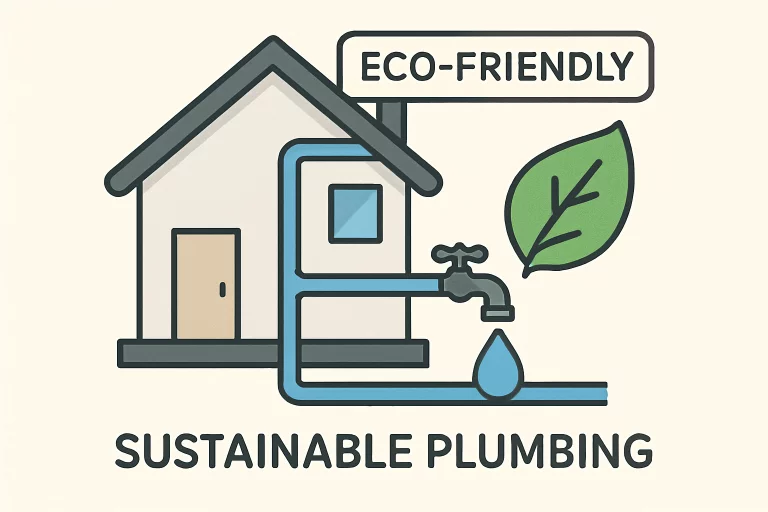Creating a truly sustainable home goes beyond installing energy-efficient appliances or mounting solar panels on your roof; it also involves thoughtful planning of your household’s plumbing infrastructure. Every drop of water that moves through your pipes presents an opportunity to make a positive environmental impact. The choices you make regarding your home’s plumbing affect not only your ecological footprint but also your monthly utility bills and overall resource efficiency. By collaborating with an experienced plumbing company, homeowners can access a wide range of eco-friendly solutions that reduce water and energy consumption, leading to both immediate and long-term savings. These upgrades are not just about today—they are about building a foundation for a greener, more responsible future.
Sustainable plumbing design benefits both the planet and your wallet. Beyond the positive environmental effects, making smart plumbing upgrades often means fewer repairs, lower utility expenses, and a higher property resale value. By investing in advanced plumbing technology and adjusting daily water-use habits, you can turn your home into a model of modern environmental stewardship. From simple fixture replacements to innovative water recycling systems, every improvement counts. These efforts collectively play a vital role in reducing stress on our water supply and ensuring clean water for future generations.
Install Low-Flow Fixtures
One of the most practical and immediately rewarding ways to promote eco-friendly plumbing in your home is to consider plumbing repair and replace traditional faucets, showerheads, and toilets with low-flow models. Conventional fixtures can waste an astonishing amount of clean, potable water every day, often more than what is truly needed for daily tasks. Modern low-flow fixtures are expertly engineered to use much less water per use, yet they don’t sacrifice the water pressure or comfort that users expect. Innovative showerheads, for example, can lower water consumption by as much as 50%, resulting in annual savings of thousands of gallons for the average household. Along with dramatically reduced water bills, homeowners also benefit from knowing they’re contributing less to water scarcity issues and environmental depletion. For more in-depth ideas, learn more about eco-plumbing tips to save water.
Upgrade to Tankless Water Heaters
The way you heat your water has a significant effect on your household’s energy usage. Standard tank water heaters store and frequently reheat large volumes of water, even when it’s not immediately needed, resulting in substantial “standby” energy losses. In contrast, tankless water heaters activate only when you turn on the hot water tap, eliminating energy wasted on keeping water hot at all times. For homes using less than 41 gallons of water daily, these systems can reduce energy consumption by up to 34%, making them an attractive option for eco-conscious households. Additionally, tankless models tend to last longer and require less space, making them ideal for smaller or modern home designs. Aside from their space efficiency, these heaters often qualify for rebates, making their upfront investment even more rewarding in the long run.

Implement Greywater Recycling Systems
Another game-changing approach to sustainable home plumbing is the installation of greywater recycling systems. Greywater is gently used water from your showers, bathtubs, bathroom sinks, and laundry—water that, after simple filtration, can be reused instead of being sent straight down the drain. By treating and rerouting this water, you can irrigate gardens, flush toilets, and sometimes even clean driveways, all without tapping into the main water supply. This deliberate reuse curbs the demand for fresh water, relieves pressure on overstretched municipal water systems, and is especially beneficial in drought-prone or water-scarce regions. Integrating a greywater system can significantly reduce your environmental footprint while ensuring your landscape or garden thrives, even during dry spells.
Harvest Rainwater
Rainwater harvesting is an ancient technique that has found renewed relevance in today’s green homes. Using a well-designed system of gutters, downspouts, and storage tanks, you can capture rainwater runoff from your roof and divert it for reuse. Not only does this help reduce your reliance on treated municipal water for non-potable needs, but it also helps manage stormwater runoff, mitigating erosion and flooding risks around your property. Collected rainwater can fulfill a surprising variety of tasks, such as watering your garden, washing cars, or even supplying water to toilets with the proper technology. Over time, the practice significantly eases the demand on public infrastructure while allowing you to enjoy a reliable, renewable resource right from the sky. Read about plumbing tips and tricks for a sustainable home.
Choose Sustainable Piping Materials
The kinds of materials used in your plumbing system have far-reaching implications for both environmental health and personal safety. Sustainable plumbing prioritizes materials that are either highly durable, easily recyclable, or have a lower overall impact during manufacturing. PEX (cross-linked polyethylene) is an increasingly popular choice—it’s tough, resists corrosion, and requires less energy to produce compared to conventional PVC. Recycled copper piping is another excellent alternative, offering remarkable longevity and the benefit of being endlessly recyclable without losing quality. Relying on these materials, rather than virgin copper or PVC, means fewer raw resources are consumed and less waste is generated in the long run. To achieve a comprehensive, eco-friendly renovation, consult with a trusted plumbing company that is well-versed in sustainable materials.
Install Smart Leak Detection System
Undetected water leaks can be a silent and expensive threat to your home. Even a small, ongoing trickle can waste huge quantities of water over time and cause significant structural damage. Modern smart leak detection systems utilize strategically placed sensors to monitor water flow patterns and automatically alert you via smartphone or smart home hubs at the first sign of a leak. Early detection means you can act swiftly to repair issues, potentially saving you thousands in damage repairs and untold gallons of wasted water each year. Some systems automatically shut off the water supply when a leak is detected, granting you ultimate peace of mind whether you’re at home or away.















